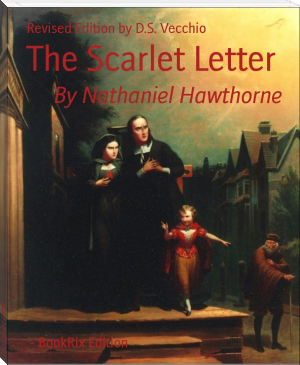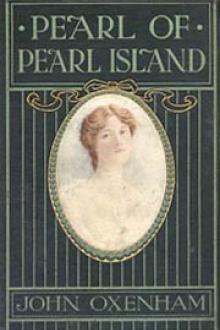The Scarlet Letter, Revised Edition by D.S. Vecchio [simple e reader txt] 📗

- Author: Revised Edition by D.S. Vecchio
Book online «The Scarlet Letter, Revised Edition by D.S. Vecchio [simple e reader txt] 📗». Author Revised Edition by D.S. Vecchio
CONTENTS
REVISION STATEMENT
ACKNOWLEDGMENTS
CONTEXT
INTRODUCTION
CHAPTER I. THE PRISON-DOOR
CHAPTER II. THE MARKET-PLACE
CHAPTER III. THE RECOGNITION
CHAPTER IV. THE INTERVIEW
CHAPTER V. HESTER AT HER NEEDLE
CHAPTER VI. PEARL
CHAPTER VII. THE GOVERNOR'S HALL
CHAPTER VIII. THE ELF-CHILD AND THE MINISTER
CHAPTER IX. THE LEECH
CHAPTER X. THE LEECH AND HIS PATIENT
CHAPTER XI. THE INTERIOR OF A HEART
CHAPTER XII. THE MINISTER'S VIGIL
CHAPTER XIII. ANOTHER VIEW OF HESTER
CHAPTER XIV. HESTER AND THE PHYSICIAN
CHAPTER XV. HESTER AND PEARL
CHAPTER XVI. A FOREST WALK
CHAPTER XVII. THE PASTOR AND HIS PARISHIONER
CHAPTER XVIII. A FLOOD OF SUNSHINE
CHAPTER XIX. THE CHILD AT THE BROOK-SIDE
CHAPTER XX. THE MINISTER IN A MAZE
CHAPTER XXI. THE NEW ENGLAND HOLIDAY
CHAPTER XXII. THE PROCESSION
CHAPTER XXIII. THE REVELATION OF THE SCARLET LETTER
CHAPTER XXIV. CONCLUSION
ADDENDUM
Book Cover
Custom House
Plot Summary
Understanding The Scarlet Letter
REVISION STATEMENT
The first major revision objective was to reduce the multitudinous use of 'commas' separating parenthetical, anecdotal and simple phrasing within a sentence. 'Commas' were also eliminated when parenthetical remarks were enclosed with paired dashes. This frequent and outdated use of 'commas' disrupted the flow of sentences and, in many cases, convoluted the author's original thought requiring a reread of the sentence. Secondly, British spelling, i.e. harbour, recognised, honoured, labour, humourous, favourable, sombre, et al., was changed to US. Thirdly, section titles were added to the “Introduction.” The section titled “A Chance Discovery” outlines the genesis of this book's story. And finally, the Puritanical dialect, i.e. "Thou strange child! Why dost thou not come to me?" exclaimed Hester. et al., was not changed.
The text for this revised edition of Nathaniel Hawthorne's The Scarlet Letter
was downloaded from “Project Gutenberg,” and this source is referenced in the “Acknowledgments.” This book was formatted for BookRix.
In addition to the “Revision Statement” and “Acknowledgments,” a section titled “Context” was added. The “Context” provides valuable insight into the author's background and a historical perspective that enhances enjoyment and understanding of the author's story.
ACKNOWLEDGMENTS
The editor of this revised edition of The Scarlet Letter
gratefully acknowledges “Project Gutenberg” for providing the original text (online and downloadable) of Nathaniel Hawthorne's The Scarlet Letter
. “Project Gutenberg” is a registered trademark. It may only be used or associated in any way with an electronic work by people who agree to “The Full Project Gutenberg License.”
The following sentence, with active links to, or other immediate access to, the full Project Gutenberg License must appear prominently whenever any copy of a “Project Gutenberg” work (any work on which the phrase "Project Gutenberg" appears, or with which the phrase "Project Gutenberg" is associated) is accessed, displayed, performed, viewed, copied or distributed:
This eBook is for the use of anyone anywhere at no cost and with almost no restrictions whatsoever. You may copy it, give it away or re-use it under the terms of the Project Gutenberg License included with this eBook or online at http://www.gutenberg.org/.
The editor is also indebted to the book Case Studies in Contemporary Criticism, Nathaniel Hawthorne, The Scarlet Letter
edited by Ross C. Murfin (St. Martin's Press: Bedford Books, 1991). This book was invaluable in authenticating Hawthorne's original text and provided a thorough history and critique of Hawthorne's classic book.
CONTEXT
Nathaniel Hawthorne was born in Salem, Massachusetts, in 1804. His family descended from the earliest settlers of the Massachusetts Bay Colony. Among his forebears was John Hathorne (Hawthorne added the “w” to his name when he began to write), one of the judges at the 1692 Salem witch trials, who never repented of his part in one of the worst atrocities committed by an early North American colonist. Throughout his life, Hawthorne was both fascinated and disturbed by his kinship with John Hathorne. Raised by a widowed mother, Hawthorne attended Bowdoin College in Maine, where he met two people who were to have great impact upon his life: Henry Wadsworth Longfellow, who would later become a famous poet, and Franklin Pierce, who would later become the 14th President of the United States.
After college, Hawthorne tried his hand at writing, producing historical sketches and an anonymous novel, Fanshawe
, that detailed his college days rather embarrassingly. Hawthorne also held positions as an editor and as a customs surveyor during this period. His growing relationship with the intellectual circle that included Ralph Waldo Emerson and Margaret Fuller led him to abandon his customs post for the utopian experiment at Brook Farm, a commune designed to promote economic self-sufficiency and transcendentalist principles. Transcendentalism was a religious and philosophical movement of the early nineteenth century that was dedicated to the belief that divinity manifests itself everywhere, particularly in the natural world. It also advocated a personalized, direct relationship with the divine in place of formalized, structured religion. This second transcendental idea figures prominently in The Scarlet Letter
.
After marrying fellow transcendentalist Sophia Peabody in 1842, Hawthorne left Brook Farm and moved into the Old Manse, a home in Concord where Emerson had once lived. In 1846, he published Mosses from an Old Manse
which was a collection of essays and stories, many of which are about early America. Mosses from an Old Manse
earned Hawthorne the attention of the literary establishment because America was trying to establish a cultural independence to complement its political independence, and Hawthorne’s collection of stories displayed both a stylistic freshness and an interest in American subject matter. Herman Melville, among others, hailed Hawthorne as the “American Shakespeare.”
In 1845 Hawthorne again went to work as a customs surveyor, this time at a post in Salem, like the narrator of The Scarlet Letter
. In 1850, after losing the job, he published The Scarlet Letter
to enthusiastic, if not widespread, acclaim. In 1853, Hawthorne’s college friend Franklin Pierce, for whom he had written a campaign biography and who had since become president, appointed Hawthorne a United States consul. The writer spent the next six years in Europe. He died in 1864, a few years after returning to America.
THE SCARLET LETTER
INTRODUCTION
AUTOBIOGRAPHICAL PARDON
It is a little remarkable, that--though disinclined to talk over much of myself and my affairs at the fireside and to my personal friends--an autobiographical impulse should twice in my life have taken possession of me in addressing the public. The first time was three or four years since, when I favored the reader--inexcusably and for no earthly reason that either the indulgent reader or the intrusive author could imagine--with a description of my way of life in the deep quietude of an Old Manse. And now I again seize the public by the button and talk of my three years' experience in a Custom House. The truth seems to be, however, that when he casts his leaves forth upon the wind, the author addresses, not the many who will fling aside his volume, or never take it up, but the few who will understand him better than most of his schoolmates or life mates. Some authors, indeed, do far more than this, and indulge themselves in such confidential depths of revelation as could fittingly be addressed only and exclusively to the one heart and mind of perfect sympathy; as if the printed book, thrown at large on the wide world, was certain to find out the divided segment of the writer's own nature and complete his circle of existence by bringing him into communion with it. It is scarcely decorous, however, to speak all, even where we speak impersonally. But, as thoughts are frozen and utterance benumbed, unless the speaker stand in some true relation with his audience, it may be pardonable to imagine that a friend, a kind and apprehensive, though not the closest friend, is listening to our talk; and then, a native reserve being thawed by this genial consciousness, we may prate of the circumstances that lie around us, and even of yourself, but still keep the inmost Me behind its veil. To this extent, and within these limits, an author, methinks, may be autobiographical, without violating either the reader's rights or his own.
It will be seen, likewise, that this Custom House sketch has a certain propriety, of a kind always recognized in literature, as explaining how a large portion of the following pages came into my possession, and as offering proofs of the authenticity of a narrative therein contained. This, in fact--a desire to put myself in my true position as editor, or very little more, of the most prolix among the tales that make up my volume--this, and no other, is my true reason for assuming a personal relation with the public. In accomplishing the main purpose, it has appeared allowable, by a few extra touches, to give a faint representation of a mode of life not heretofore described, together with some of the characters that move in it, among whom the author happened to make one.
This old town of Salem--my native place, though I have dwelt much away from it both in boyhood and maturer year--possesses, or did possess, a hold on my affection, the force of which I have never realized during my seasons of actual residence here. Indeed, so far as its physical aspect is concerned, with its flat, unvaried surface, covered chiefly with wooden houses, few or none of which pretend to architectural beaut--its irregularity, which is neither picturesque nor quaint, but only tame--its long and lazy street, lounging wearisomely through the whole extent of the peninsula, with Gallows Hill and New Guinea at one end, and a view of the alms-house at the other--such being the features of my native town, it would be quite as reasonable to form a sentimental attachment to a disarranged checker-board. And yet, though invariably happiest elsewhere, there is within me a feeling for Old Salem, which, in lack of a better phrase, I must be content to call affection. The sentiment is probably assignable to the deep and aged roots which my family has stuck into the soil. It is now nearly two centuries and a quarter since the original Briton, the earliest emigrant of my name, made his appearance





Comments (0)